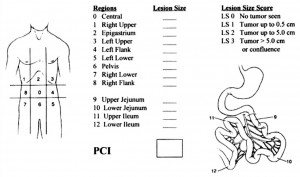Calculating the Peritoneal Cancer Index
The peritoneal cancer index (PCI) is used to assess the extent of peritoneal cancer throughout the peritoneal cavity. For this purpose, the peritoneal cavity is divided in 13 well-defined regions (see figure). In each of the 13 regions, the size of the largest tumor nodule is measured. If no tumor is visualized, a score of “0” is given to that region. If the largest tumor nodule is smaller than 0.5 cm, the score is “1”. For tumors measuring between 0.5 cm and 5 cm, the score is “2”. For lesions larger than 5 cm, the score is “3”. If there is layering or a confluence of multiple small tumor nodules, the score is “3”. The PCI is calculated by adding the scores of all 13 regions together with a maximum score of 39 (13×3).
In colorectal cancer, the PCI is closely correlated with the prognosis after HIPEC. The higher the PCI, the worse the prognosis. Most institutes have defined a maximum PCI. If a patient’s PCI exceeds this upper limit, the operation is terminated, and the HIPEC procedure is cancelled because the benefit of the procedure in terms of survival does not outweigh its risks.
A diagnostic laparoscopy may be helpful in determining the PCI as can be seen in the video:
This approach may be different for other forms of peritoneal cancer, such as low-grade pseudomyxoma peritonei. These patients may be successfully treated with excellent long-term outcomes despite having a very high PCI. In these patients, the prognosis is determined by the ability to radically remove the tumor rather than the PCI prior to removal.
Source of PCI-picture:
“Quantitative prognostic indices in peritoneal carcinomatosis” by Dr FN Gillen and collegues, the European Journal of Surgical Oncology (2006) (view in Pubmed)

